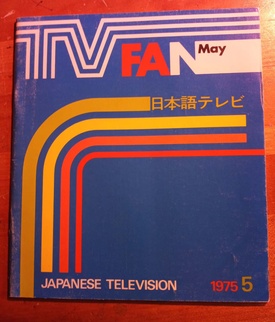Introducing Japanese TV programs
I first started working as a freelance writer in 2003, and the magazine I wrote for was TV FAN. I continued to write for the magazine until its last publisher, Hiroshi Takeuchi, stopped publication in 2010. After it went out of publication, when I went to Japanese events, readers would often ask me, "Is TV FAN no longer being published?" It's been 11 years since then, and I don't get asked that question anymore, but when I was asked that question, I realized once again that TV FAN had a lot of devoted readers.
I wrote that Takeuchi was the "last publisher" because there were two publishers before him. The magazine was first published in 1975. The late Tsukahara Kokichi launched it as a magazine introducing Japanese TV programs broadcast in Los Angeles. At the time, there were apparently four broadcasting stations for Japanese TV programs, and in an era before the Internet, the Japanese community lived their daily lives looking forward to watching Japanese programs, including dramas. I heard that when the dramas were broadcast, people would disappear from the streets of Little Tokyo.
TV FAN, which published articles introducing these programs, also had a popular column tracing the history of the Japanese community. As a Japanese-language magazine where readers could find out the details of TV programs and also gain a deeper understanding of the Japanese community in which they lived, the magazine was supported by devoted readers even during the time of Tsukahara's successor, the late Katagiri Nobuyuki, as publisher.
Takeuchi bought the business from Katagiri in 1998. Until then, Takeuchi had been the president of a US subsidiary of a Japanese company, but when the parent company went bankrupt, he was forced to seek a new career. The job he chose was to become the third-generation publisher of TV FAN, a magazine where he had written film reviews in his younger days.
When asked why he decided to become a magazine publisher, Takeuchi, who is now retired and lives near San Diego, replied, "I worked part-time at a magazine called Kinema Junpo when I was a university student in Japan. Maybe that experience is what got me interested in editing work from the start. When I became publisher, we had about four or five pages of TV introductions. We also had seven or eight writers (of essays). We changed from offset printing to rotary presses, increased the number of pages, and increased the circulation to 15,000."
Why did they keep the name of the magazine as "TV FAN" even though TV reviews were no longer the main content at that time? In response to this question, they answered, "The name 'TV FAN' had become so deeply ingrained among our readers that we decided it would be better not to change it."
Bringing light to the lives of Japanese Americans
Takeuchi's generation also began to try new things. "We started a project called 'Every Person Has a History,' which introduced the achievements of people who were active in Japanese society, and we also set up an English page for the new generation of Japanese from the third generation onwards who do not understand Japanese. We also put together a special feature on the theme of 'heritage,' aimed at a relatively older readership.' That issue sold out in the blink of an eye after it was distributed, and Takeuchi says he received many phone calls asking where they could get a copy.
In parallel with publishing the magazine, he acquired the rights to publish books such as "Citizenship Publication Guide" and "Japanese Names for Babies," and sold them in Japanese bookstores. He also ordered books related to Japanese people from Japanese publishers and advertised them in the magazine, which was a great success. "When we advertised in the book by author Masakiyo Watanabe, we sold nearly 200 copies," he recalls.

Furthermore, Takeuchi had a dream he wanted to achieve through TV FAN. "I wanted to nurture a writer. That didn't come true, but when one of the writers who had submitted their work to us a few times was published in Bungeishunju's Humans Are Amazing: The Best Essay Collection of 2011, I felt that it was a good thing, even though I wasn't the one who nurtured that writer." In addition to TV program introductions, essays and special features, interviews with people, and cooking, the magazine also had a section for submitting tanka and haiku, further strengthening its image as a "monthly magazine that nurtures Japanese culture," as per its catchphrase.
However, since 2000, the number of Japanese companies expanding into the country has decreased, and the free magazine, which was supported by advertising revenue, has been facing financial difficulties. In addition to the free distribution, the magazine had 800 regular subscribers across the United States, but "because the readers are older, the number of readers who can read Japanese may decrease over time, but it never increases." So, in 2010, Takeuchi decided to cease publication.
We asked him what he gained from his experience publishing TV FAN for 12 years: "I have gained a deeper understanding of the way of life of Japanese Americans. I have not only highlighted famous people, but also unknown people, and introduced their lives through the magazine. What made me happy was that we received a request from a museum in Chicago to donate all of their issues of TV FAN as a record of the Japanese American community. When we appealed to readers through the magazine, we found that two people had kept 360 copies of the magazine, starting from the first issue in 1975."
TV FAN is not an information magazine that is read and then discarded, but is loved as a magazine that you want to read over and over again. I have been involved as a writer for nearly 10 years, and I keep all the issues from that period carefully stored on my bookshelf.
© 2022 Keiko Fukuda







